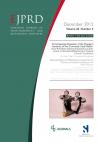European Journal of Prosthodontics and Restorative Dentistry

- Cover Date:
- December 2012
- Print ISSN:
- 0965-7452
- Vol:
- 20
- Issue:
- 4
Reproducibility of 2 Methods to Locate Centric Relation in Healthy Individuals and TMD Patients
Abstract - No conclusive evidence exists for any maxillomandibular relationship as the preferable treatment position. Measurement reliability of 2 different methods to attempt to locate centric relation in control and TMD patients was assessed to determine if both methods lead to the same position. A group of 27 controls and 91 TMD patients were examined using the Research Diagnostic Criteria for TMD (RDC/TMD). Three patient groups were recruited: 27 patients with myofascial pain (MYO), 34 patients with disc displacement without reduction (ID), and 30 patients with osteoarthritis (OA). For each study participant centric relation was located with chinpoint guidance and a technique with a leaf gauge, for the controls once, for all TMD patients before and after stabilization splint treatment. The mixed model procedure revealed no significant differences between the methods, the patient groups and the time interval. However, the patient groups at baseline and conclusion of treatment differed significantly from the controls. The percentage of patients (15.9%) having a coincident split-cast result for both methods was significantly smaller (P<0.001) than the corresponding percentage (85.2%) of controls. After splint treatment, the percentage of coincident split-casts increased from 15.9% to 76.8%. Both methods are reproducible techniques to locate centric relation for control and TMD patients. However, the leaf gauge provides the clinician a different centric relation position in TMD patients than chinpoint guidance does.
KEY WORDS: Centric relation, TMD, reproducibility, split-cast
- Article Price
- £15.00
- Institution Article Price
- £
- Page Start
- 151
- Page End
- 158
- Authors
- A.J.J. Zonnenberg, J. Mulder
Articles from this issue
- Title
- Pg. Start
- Pg. End
- A Comparative Evaluation of the Change in Hardness, of Two Commonly Used Maxillofacial Prosthetic Silicone Elastomers, as Subjected to Simulated Weathering In Tropical Climatic Conditions
- 146
- 150
- Reproducibility of 2 Methods to Locate Centric Relation in Healthy Individuals and TMD Patients
- 151
- 158
- Flexural Strength and Degree of Polymerization of a Proprietary Denture Base Acrylic Resin Designed to be Cured using Long or Short Cycles
- 163
- 167
- Are Implant Supported Overdentures too Complex to be Included in the Undergraduate Curriculum?
- 176
- 180
